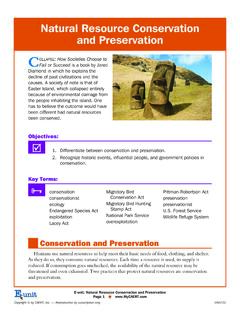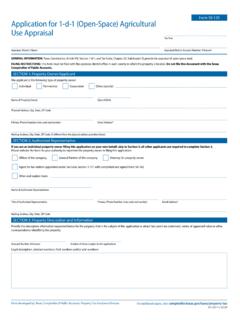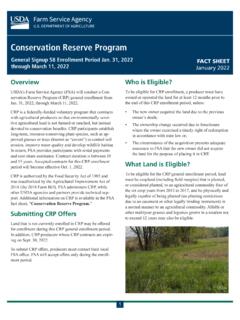Transcription of OPEN STANDARDS FOR THE PRACTICE OF CONSERVATION
1 OPEN STANDARDSFOR THE PRACTICE OF CONSERVATIONVERSION | 2020 DIANE DETOEUF / wildlife CONSERVATION SOCIETYOPEN STANDARDS FOR THE PRACTICE OF CONSERVATION Use of this Material: This work is licensed for use under a Creative Commons Attribution-ShareAlike International License. Under this license, you may take the CONSERVATION STANDARDS and adapt or modify them as you see fit, provided you a) reference the original CONSERVATION STANDARDS (but not in any way that suggests that CMP endorses this derived work), and b) issue the derived work under a similar Creative Commons license or equivalent.
2 You can also formally contribute your modifications to CMP, which will consider incorporating them in a future official version of the CONSERVATION STANDARDS . This process ensures that the STANDARDS evolve through the input of a wide variety of practitioners, are adaptable to individual organizations needs, and yet provide a carefully managed global standard for CONSERVATION work. i ABOUT THIS DOCUMENT The Open STANDARDS for the PRACTICE of CONSERVATION Version is the product of inputs, field tests, and discussions among members of the CONSERVATION Measures Partnership (CMP), which has final editorial authority over the CONSERVATION STANDARDS .
3 Substantial input was also provided by members of the CONSERVATION Coaches Network (CCNet) and other CMP partners. What Is the CONSERVATION Measures Partnership (CMP)? CMP is a partnership of CONSERVATION -oriented NGOs, government agencies, and funders that works collectively to achieve greater impact. We seek better ways to design, manage, and measure the impacts of our CONSERVATION actions so that we can learn and improve our efforts and contribute our learning to the broader evidence base. Current CMP members: African wildlife Foundation; Bush Heritage Australia; CONSERVATION International; The David and Lucile Packard Foundation; Disney s Animals, Science, and Environment; Durrell wildlife CONSERVATION Trust; Foundations of Success; The Gordon and Betty Moore Foundation; International Crane Foundation; International Fund for Animal Welfare; Jane Goodall Institute; Keith Campbell Foundation for the Environment; Margaret A.
4 Cargill Foundation; National Fish and wildlife Foundation; The Nature Conservancy; Nature Conservancy of Canada; Nature Serve; Puget Sound Partnership; Rare; The Summit Foundation; US Agency for International Development; US Fish and wildlife Service; Walton Family Foundation; wildlife CONSERVATION Network; wildlife CONSERVATION Society; and WWF. Revisions and Updates: The CONSERVATION Measures Partnership has approved this document. However, as part of the adaptive management process, CMP members will continue to revise and improve it over time.
5 For updated versions, guidance materials, and further information about CMP, visit CMP s website at: and the CONSERVATION STANDARDS website at: We encourage feedback from anyone who uses these STANDARDS please e-mail us at: CONSERVATION STANDARDS Revisions Committee: The following individuals worked together to develop and refine the content reflected in this version. CMP is grateful to them for their time and insights. Annette Stewart (Bush Heritage Australia), Ari Cornman (California Fish and Game Commission), Arlyne Johnson (Foundations of Success), Ashleigh Baker (Foundations of Success), Brad Northrup ( CONSERVATION Coaches Network), Caroline Stem (Foundations of Success), Catherine Payne (Durrell wildlife CONSERVATION Trust), Diane Detoeuf ( wildlife CONSERVATION Society), Clair Dougherty (Bush Heritage Australia), Dan Salzer (The Nature Conservancy), Felix Cybulla (Independent, CONSERVATION Coaches Network)
6 , Gustavo Gatti (Conserve Brazil), Hui Shim Tan (WWF-Malaysia), Ilke Tilders (Foundations of Success), Irina Montenegro (WWF Chile), John Morrison (WWF US), Judy Boshoven (Foundations of Success), Kerryn Morrison (Endangered wildlife Trust), Lydia Gaskell (WWF International), Marcia Brown (Foundations of Success), Mariano de la Maza (CONAF Chile), Mariella Saenz (Pronatura), Nick Salafsky (Foundations of Success), Oscar Maldonado (Independent, CONSERVATION Coaches Network), Patrick Crist (PlanIt Forward), Philippa Walsh (Community Solutions), Sandra Andraka (UNDP), Thomas Miewald (US Fish and wildlife Service), and Will Beale (WWF-UK).
7 In addition, CMP is grateful to the individuals of the CONSERVATION STANDARDS community who reviewed various versions of the CONSERVATION STANDARDS and provided important input to refine and improve STANDARDS FOR THE PRACTICE OF CONSERVATION ii TABLE OF CONTENTS Introduction 1 Background 2 Purpose of the CONSERVATION STANDARDS 3 Inception and Evolution of the CONSERVATION STANDARDS 4 Relationship of the CONSERVATION STANDARDS to Other Decision Support Frameworks 5 Using the CONSERVATION STANDARDS 6 Support for
8 Implementing the CONSERVATION STANDARDS 7 General Principles and Considerations 9 1. Assess 12 1A. Define Purpose and Identify Project Team 13 1B. Define Scope, Vision, and CONSERVATION Targets 14 1C. Identify Critical Threats 19 1D. Assess the CONSERVATION Situation 21 2. Plan 26 2A. Develop a Formal Action Plan: Goals, Strategies, Assumptions, and Objectives 27 2B. Develop a Formal Monitoring, Evaluation, and Learning Plan 38 2C. Develop an Operational Plan 44 3. Implement 46 3A. Develop a Detailed Short-Term Work Plan and Timeline 47 3B.
9 Develop and Refine Your Project Budget 49 3C. Implement Your Plans 50 4. Analyze and Adapt 54 4A. Prepare Your Data for Analysis 55 4B. Analyze and Reflect on Results 56 4C. Adapt Your Strategic Plan 58 5. Share 60 5A. Document What You Learn 61 5B. Share What You Learn 61 5C. Foster a Learning Envronment 63 Close the Loop 65 Annexes 67 Annex 1. Glossary 68 Annex 2. Definitions of and Criteria for Key Terms 72 Annex 3. General Principles and Considerations 73 Annex 4. Summary of STANDARDS of PRACTICE and Outputs 76 OPEN STANDARDS FOR THE PRACTICE OF CONSERVATION 1 INTRODUCTION PHOTO: PETER CHIRA / AFRICAN wildlife FOUNDATION OPEN STANDARDS FOR THE PRACTICE OF CONSERVATION 2 BACKGROUND The CONSERVATION community is tackling large, complex, and urgent environmental problems where the stakes are high.
10 People around the world are counting on us; they trust us, they work alongside us, and they are giving us significant resources to act effectively to save the planet. We have great potential to have lasting impact, and indeed, we have made inspiring advances. Even so, few CONSERVATION organizations or agencies can provide evidence for what is working, what needs improvement, and what should change. Without more rigorous measurement of effectiveness and disciplined recording of our efforts, how will we know if we are progressing as rapidly as needed to achieve our CONSERVATION goals?







